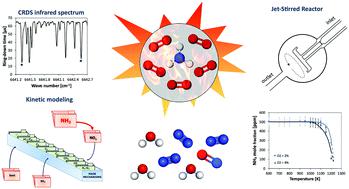当前位置:
X-MOL 学术
›
React. Chem. Eng.
›
论文详情
Our official English website, www.x-mol.net, welcomes your feedback! (Note: you will need to create a separate account there.)
An experimental, theoretical and kinetic-modeling study of the gas-phase oxidation of ammonia
Reaction Chemistry & Engineering ( IF 3.9 ) Pub Date : 2020-02-21 , DOI: 10.1039/c9re00429g Alessandro Stagni 1, 2, 3, 4, 5 , Carlo Cavallotti 1, 2, 3, 4, 5 , Suphaporn Arunthanayothin 6, 7, 8, 9 , Yu Song 6, 7, 8, 9, 10 , Olivier Herbinet 6, 7, 8, 9 , Frédérique Battin-Leclerc 6, 7, 8, 9 , Tiziano Faravelli 1, 2, 3, 4, 5
Reaction Chemistry & Engineering ( IF 3.9 ) Pub Date : 2020-02-21 , DOI: 10.1039/c9re00429g Alessandro Stagni 1, 2, 3, 4, 5 , Carlo Cavallotti 1, 2, 3, 4, 5 , Suphaporn Arunthanayothin 6, 7, 8, 9 , Yu Song 6, 7, 8, 9, 10 , Olivier Herbinet 6, 7, 8, 9 , Frédérique Battin-Leclerc 6, 7, 8, 9 , Tiziano Faravelli 1, 2, 3, 4, 5
Affiliation

|
A complete understanding of the mechanism of ammonia pyrolysis and oxidation in the full range of operating conditions displayed by industrial applications is one of the challenges of modern combustion kinetics. In this work, a wide-range investigation of the oxidation mechanism of ammonia was performed. Experimental campaigns were carried out in a jet-stirred reactor and a flow reactor under lean conditions (0.01 ≤ Φ ≤ 0.375), such to cover the full range of operating temperatures (500 K ≤ T ≤ 2000 K). Ammonia conversion and the formation of products and intermediates were analyzed. At the same time, the ammonia decomposition reaction, H-abstractions and the decomposition of the HNO intermediate were evaluated ab initio, and the related rates were included in a comprehensive kinetic model, developed according to a first-principles approach. Low-temperature reactor experiments highlighted a delayed reactivity of ammonia, in spite of the high amount of oxygen. A very slow increase in NH3 consumption rate with temperature was observed, and a full reactant consumption was possible only ∼150–200 K after the reactivity onset. The use of flux analysis and sensitivity analysis allowed explaining this effect with the terminating effect of the H-abstraction on NH3 by O2, acting in the reverse direction because of the high amounts of HO2. The central role of H2NO was observed at low temperatures (T < 1200 K), and H-abstractions from it by HO2, NO2 and NH2 were found to control reactivity, especially at higher pressures. On the other side, the formation of HNO intermediate via NH2 + O = HNO + H and its decomposition were found to be crucial at higher temperatures, affecting both NO/N2 ratio and flame propagation.
中文翻译:

氨气气相氧化的实验,理论和动力学模型研究
全面了解工业应用所显示的整个运行条件下氨气热解和氧化的机理是现代燃烧动力学的挑战之一。在这项工作中,对氨的氧化机理进行了广泛的研究。实验运动是在一个喷流搅拌反应器和贫燃条件下流动反应器(0.01≤进行Φ ≤0.375),例如,以覆盖全范围的操作温度(500K的≤的Ť ≤2000 K)。分析了氨的转化以及产物和中间体的形成。同时,从头开始评估了氨分解反应,H吸附和HNO中间体的分解。,并且相关速率已包含在根据第一原理方法开发的综合动力学模型中。低温反应器实验强调了尽管有大量的氧气,但氨的反应性延迟。观察到NH 3消耗速率随温度的升高非常缓慢,反应开始后仅约150-200 K即可完全消耗反应物。通量分析和灵敏度分析的使用允许用O 2的H吸收对NH 3的终止作用来解释这种效应,由于HO 2的含量较高,O 2的作用相反。H的中心作用2在低温下观察到NO(Ť(<1200 K),并发现HO 2,NO 2和NH 2对其进行H吸收可控制反应性,特别是在较高压力下。另一方面,发现在较高温度下,通过NH 2 + O = HNO + H形成HNO中间体及其分解至关重要,这会影响NO / N 2比和火焰传播。
更新日期:2020-02-21
中文翻译:

氨气气相氧化的实验,理论和动力学模型研究
全面了解工业应用所显示的整个运行条件下氨气热解和氧化的机理是现代燃烧动力学的挑战之一。在这项工作中,对氨的氧化机理进行了广泛的研究。实验运动是在一个喷流搅拌反应器和贫燃条件下流动反应器(0.01≤进行Φ ≤0.375),例如,以覆盖全范围的操作温度(500K的≤的Ť ≤2000 K)。分析了氨的转化以及产物和中间体的形成。同时,从头开始评估了氨分解反应,H吸附和HNO中间体的分解。,并且相关速率已包含在根据第一原理方法开发的综合动力学模型中。低温反应器实验强调了尽管有大量的氧气,但氨的反应性延迟。观察到NH 3消耗速率随温度的升高非常缓慢,反应开始后仅约150-200 K即可完全消耗反应物。通量分析和灵敏度分析的使用允许用O 2的H吸收对NH 3的终止作用来解释这种效应,由于HO 2的含量较高,O 2的作用相反。H的中心作用2在低温下观察到NO(Ť(<1200 K),并发现HO 2,NO 2和NH 2对其进行H吸收可控制反应性,特别是在较高压力下。另一方面,发现在较高温度下,通过NH 2 + O = HNO + H形成HNO中间体及其分解至关重要,这会影响NO / N 2比和火焰传播。



























 京公网安备 11010802027423号
京公网安备 11010802027423号